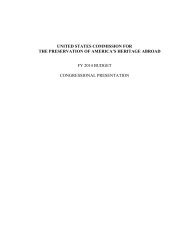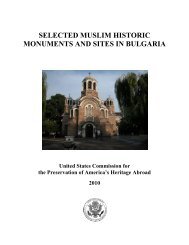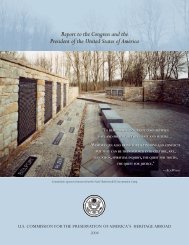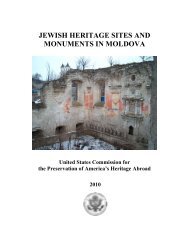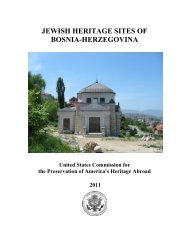jewish cemeteries, synagogues, and mass grave sites in ukraine
jewish cemeteries, synagogues, and mass grave sites in ukraine
jewish cemeteries, synagogues, and mass grave sites in ukraine
You also want an ePaper? Increase the reach of your titles
YUMPU automatically turns print PDFs into web optimized ePapers that Google loves.
IV.4<br />
Holocaust Execution <strong>and</strong> Mass Burial Sites<br />
Throughout Ukra<strong>in</strong>e, many Holocaust <strong>sites</strong> are marked <strong>and</strong> cared for – a cont<strong>in</strong>uation of a policy<br />
from Soviet times that designated memory to “victims <strong>and</strong> martyrs of Fascism.” Until recently,<br />
most of these marked <strong>sites</strong> made no mention of the Jewish identity of the victims<br />
commemorated. Most famously, this was the case at Babyn Yar, the kill<strong>in</strong>g site of Kyiv’s Jews,<br />
not far from the city limits, but it was also true elsewhere throughout all the former Soviet<br />
Union.<br />
In Lutsk, for example, the <strong>mass</strong> <strong>grave</strong>site of thous<strong>and</strong>s of Jews killed <strong>in</strong> that city between August<br />
20 <strong>and</strong> September 3, 1942 bore only a stone marker that did not identify the victims as Jews. In<br />
July 1990, however, Soviet officials allowed the dedication of a new memorial at this site. Three<br />
thous<strong>and</strong> people attended the ceremony. The new granite <strong>and</strong> marble monument commemorates,<br />
<strong>in</strong> Yiddish <strong>and</strong> Ukra<strong>in</strong>ian, the 25,658 people of “Jewish nationality” killed on that spot. The new<br />
monument was paid for by the Government of Ukra<strong>in</strong>e, except for a cast-iron fence surround<strong>in</strong>g<br />
the <strong>grave</strong>site that was funded by the New York-based Federation of Volhynia Jews. In all,<br />
thirty-eight <strong>grave</strong>site renovations were planned <strong>in</strong> Volhynia - under the direction of the Volhynia<br />
Museum <strong>in</strong> Lutsk. 49<br />
Most <strong>mass</strong> burial <strong>sites</strong> <strong>in</strong> Ukra<strong>in</strong>e, however, rema<strong>in</strong> poorly marked <strong>and</strong> uncared for. Without<br />
prompt action, the knowledge of many of these places will disappear as the generation that<br />
suffered the horrors of the Holocaust passes.<br />
The need to recognize <strong>and</strong> commemorate these places is <strong>in</strong> the hearts of survivors <strong>and</strong> relatives<br />
of those murdered. One example st<strong>and</strong>s for many. In 1999, Chaim Fischman made a pilgrimage<br />
to Tsybulivka (V<strong>in</strong>nytska oblast), where he had survived the freez<strong>in</strong>g w<strong>in</strong>ter of 1941-42 herded<br />
with other Jews “like cattle … Many … died, either from frost, starvation, typhoid fever, or other<br />
illness. I was fortunate enough to survive that w<strong>in</strong>ter, but my father was not …”.<br />
Fischman’s father was buried <strong>in</strong> a <strong>mass</strong> <strong>grave</strong> with thous<strong>and</strong>s (perhaps as many as 5,000) people<br />
who perished that w<strong>in</strong>ter. On his return <strong>in</strong> 1999, Fischman found little changed <strong>in</strong> the<br />
impoverished, rural area. “The ma<strong>in</strong> field which holds the rema<strong>in</strong>s of the thous<strong>and</strong>s of martyrs,<br />
<strong>in</strong>clud<strong>in</strong>g my father’s f<strong>in</strong>al rest<strong>in</strong>g place, is now be<strong>in</strong>g used for cattle graz<strong>in</strong>g, without any<br />
fenc<strong>in</strong>g or mark<strong>in</strong>g to <strong>in</strong>dicate its holy status.” 50<br />
In the fall of 2000, work to build a fence around the <strong>mass</strong> burial place was underway <strong>in</strong><br />
cooperation with Rabbi Tsirkus from V<strong>in</strong>nytsia.<br />
In the village of Brailiv near V<strong>in</strong>nytsia, a wall enclos<strong>in</strong>g a <strong>mass</strong> <strong>grave</strong> <strong>and</strong> a commemorative<br />
monument for the 3,000 Jews killed <strong>and</strong> buried on this site was erected by survivors shortly after<br />
the end of the Second World War. This is a case where an early effort was made to mark a site<br />
of shame for future generations. However, the orig<strong>in</strong>al monument decayed. As a result, a new<br />
effort restored the monument, at which time additional plaques were added, identify<strong>in</strong>g as many<br />
as possible of the murdered <strong>in</strong>dividuals. This new monument was sponsored by the<br />
49 See Toby Axelrod, “Soviets Dedicate Memorial to Jews,” The Jewish Week (July 27, 1990).<br />
50 Letter from Chaim Fischman to then Commission Chairman Michael Lewan, December 9, 1999.<br />
53




